Abstract
This paper presents the development and use of digital tools in the maintenance processes and ergonomics of work systems in the aerospace industry. The Industry 4.0 strategy aims to ensure the reliability of the human factor throughout the entire lifecycle of the maintenance process in the aerospace industry. Based on the requirement placed on the digital model of the working environment obtained from the 3D scanner data, an advanced software solution from TECNOMATIX, namely the TX JACK software 16.1.0 module, was used. The investigated digital ergonomic model, with two variants of workers with anthropometrically different weights, is the subject of analysis and simulation of the maintenance work process in an aerospace organization. Furthermore, the research also shows how the workers of maintenance and repair organizations are willing to develop their own knowledge and skills. The aviation industry should invest in the development of reliable software and hardware, improve safety at the level of digital ergonomics and the quality of jobs involving digitalization, and offer appropriate training for safety and quality personnel. The aim of this paper is to ensure the reliability of the human factor in the maintenance process and, consequently, to ensure technical safety by means of innovative tools in practice. The findings suggest that the investigated TESTER-STEND model with high-end adjustable pistons will improve ergonomics, worker performance, and work safety as a whole.
1. Introduction
Human interaction with technology is strongly influenced by its reliability. New technology often brings completely new phenomena in human behavior and paradoxically reduces the ability to cope with emergencies. This paper highlights some new phenomena in human behavior as we predict them and try to deal with them. Efforts in the field of technical reliability are moving towards a trend of increasing technology reliability and overall safety [1].
One of the key elements that define the working environment in manufacturing is ergonomics. The working activities must be constantly observed in addition to creating a production system using an ergonomic approach. It is especially important when the volume of changes in production results in altered cycle times, which alter worker conditions and workload. Much research in the literature and worldwide standards have shown that lesions or modifications of the muscles, nerves, tendons, and joints are brought on by extended exposure to unnatural working postures, applied forces, material manual handling, and repetitive motions [2].
The evaluation process is time-consuming and entirely subjective, and since the methods are observational and primarily dependent on the creation of specific checklists, it does not ensure the reproducibility of data. Due to these factors, creating numerical approaches and measurement tools has become an essential concern for businesses in the age of Industry 4.0, which requires efficient and secure production processes.
Many studies on digital human modeling and simulation for evaluating ergonomics indices have been published in the literature. In order to evaluate the ergonomics of working activities, Caputo et al. [3,4] defined experimental and numerical procedures using simulation and an inertial motion tracking system separately. In Caputo et al. [3], experimental data were utilized to validate the numerical model by comparing experimental and numerical findings. During the design stage of a new production line, the authors provided a framework for preventively analyzing the ergonomic indices, particularly the Ergonomic Assessment Work-Sheet (EAWS). Some ergonomic indicators were examined in [4]; numerical models were used to validate the design of a new workstation.
As shown by Makarova et al. [5], process indicators and ergonomic indices can be investigated in a virtual environment. Case et al. [6] used simulated data based on human abilities to investigate the aging of employees. Tarallo et al. proposed [7] a computer-aided production management system that incorporates Industry 4.0 concepts into a manual work environment using digital human models.
Real and virtual ergonomic tools were used by Sanjog et al. in [8] to assess workplace ergonomics in an industrial workshop. Simulations and digital human models can be of great help to ergonomists or production managers in selecting the best design for a safe workplace. Greco et al. [9] presented a methodological approach that facilitates the evaluation and decision making in relation to the ergonomic capabilities of manual manufacturing lines by deploying a human digital twin. Their findings demonstrate how it is possible to recognize the functional problems with a manual workspace and how it is possible to recommend and test fixing them.
Ergonomic office design reduces postural stress, increases productivity in the company, increases job satisfaction, and improves work–life balance [10,11]. The study of digital prototypes in a virtual environment reduces development and design time costs [12]. Work cell designs in automotive plants have improved due to the application of digital human modeling in the workplace [13].
In particular, among the enabling technologies, the combined use of simulation tools and the Industrial Internet of Things (IoT) enables the monitoring of worker performance, improving process control, and nearly-real-time management of the entire production line in terms of balance and ergonomics [14].
Wearable motion tracking technology has gained enormous traction in the factory setting in recent years. They enable the collection of motion data during routine work activities and their analysis in order to assess ergonomic indices related to the biomechanical load brought on by working postures due to their high accuracy and minimum invasiveness [15,16].
Working conditions have a significant impact on a person’s health, working ability, alertness, and overall productivity. In the Slovak Republic and elsewhere, the number of musculoskeletal system diseases, injuries, and occupational diseases is increasing. Employers face increased costs related to workers’ compensation and loss of production due to a high accident rate resulting from a lack of information about ergonomic principles in workplace design.
Therefore, it is important to understand biomechanics and its elements, which evaluate the human organism as a whole. In the current era of modern technologies, there is a wealth of information available about software support for virtual design. This can simulate any workplace and prevent mistakes in the real design before the company enters the business environment.
Currently, every organization uses ergonomics in a different way. It depends on the type of production, the way it is managed, the attitudes of workers, their understanding of ergonomics, cooperation with health services, and many other elements. One element is curiosity about how other companies apply ergonomics and the desire to do the same. Both positive and negative experiences can inspire and provide direction for completing one’s own goals and challenges.
In a virtual manufacturing model, early detection of ergonomic problems reduces the time and cost of finding solutions [17], protects workers from unnecessary risk of harm, and improves workplace well-being [18,19].
Assessing ergonomic problems early in the design process is more cost-effective and efficient than waiting until later. This enables the early detection of problems and application of corrective measures [20,21,22].
The need for an in-depth understanding of the workers’ visual activity throughout a task has been modeled [23]. Moreover, engineers must complete a significant amount of training [22]. Virtual reality could also increase the effectiveness and realism of virtual manufacturing [24]. It is important to support different parts of the process, such as accuracy difficulties [25]. In addition to the limitations in the use of digital human modeling technology, we have to provide an analysis of physical ergonomics.
Two commonly performed working postures are kneeling or working overhead. There is a need to create virtual ergonomics analysis for maintenance methods that are human-centered.
We conducted a literature review to identify previous research related to digital ergonomics and human factors.
A study from 2019 [26] discusses the applicability of a scientific assessment method to maintenance within the approach. According to [27], ergonomics is the content of work tools, work environment, and work in general. and their adaptation to the characteristics, abilities, and data of employees.
There are three types of ergonomics (organizational, cognitive, and physical) which deal with the optimizing interaction between humans and other system elements; ergonomics uses theory, knowledge, principles, data, and methods to optimize human well-being and performance [28,29]. As long as the design process and the creation of the concept are people-oriented, and ergonomic issues during operation are taken into account, the demands on the operability and usability of the product can be increased to a certain extent [30].
Also, Van der Molen et al. [31] argue that workers’ actual knowledge of their jobs should be taken into account since, for instance, their experience and expertise should help them better understand how to deal with danger and regulate it. A Participatory Ergonomics program led to various improvements at an industrial facility, according to research by Tompa et al. [32]. Even though the enhancements were low-cost and technologically advanced, they had a significant positive influence on output and performance as well as on the health and happiness of the workforce [33]. The assessment of this circumstance prompted Koglind-human [34] to research new participation-based approaches that allow workers to proactively alter their work environment.
This research focused on maintenance and repair organizations, specifically aircraft brake maintenance. There are several workstations that are present in maintenance and repair organizations; however, only one is addressed in the present study. At the company’s request, the current research focuses on a workstation that focuses on checking a part of the aircraft brake, namely the piston cylinder block.
Procedures for ergonomic risk assessment are employed in relation to two worker variants with anthropometrically different parameters. During a snapshot of the working day, critical passages of the workers’ positions were specified and analyzed to determine the level of risk, and the results were evaluated to be acceptable or unacceptable. Unacceptable results were examined, and they led to the design of a technical solution for workstation modification. The assessment and prevention of biomechanical overload danger in the workplace depend on the analysis of the workers’ postural attitudes while interacting with the components of their workstations and the surrounding environment. There are two simple approaches for assessing occupational postural risk: RULA (Rapid Upper Limb Assessment) [35] and REBA (Rapid Entire Body Assessment) [36].
Indeed, prior research [37,38] demonstrated that observational methods, which have the benefit of being more adaptable and less time- and resource-intensive than objective laboratory assessments, are regarded beneficial in the assessment of biomechanical work-related stress. Both RULA and REBA make it possible to determine the urgency of an intervention and the necessary steps by obtaining a numerical index that quantifies the danger to which the worker is exposed while doing the specified work activity.
The RULA method [39] divides the body into various components that are grouped into two groups, A and B. Group A contains the arm, forearm, and wrist of the right and left limb. Group B includes the neck, spine, and feet. The method involves giving each segment a score depending on the posture adopted, and it enables the creation of two distinct scores (Scores A and B) through the use of numerical tables or spreadsheets. These scores represent the degree of postural load on the musculoskeletal system, which is determined by the combination of the postures of the entire body. Then, Scores A and B are increased by the muscle use and force scores to produce two new scores (Scores C and D), which are then multiplied by a third table or a spreadsheet, allowing for the obtainment of the final score, or Grand Score. The final score may fall between 1 and 7 depending on the right combination of scores. Four levels of action and four levels of risk contribute to the final score [40,41].
The use of digital tools can speed up ergonomic analyses and help avoid some of the biases associated with observational methods [42]. Reverse engineering is used as a systematic technique for rebuilding 3D models of existent items to conduct precise inspections and quality control, and for estimating accurate product performance [43].
Inappropriate digital factory design, lack of adaptability/flexibility, cramped workspace, and attention/memory lapses increase the likelihood of being associated with increased risk and overall workplace hazards [44].
Table 1 provides a summary of RULA’s scores, actions, and risk levels, with low-risk action being level 1. If the posture is not maintained or repeated for extended periods of time, it receives a score of 1 or 2.

Table 1.
Rula and Reba cores with the respective action level [24].
Action level 2: Moderate risk. A score of 3 or 4 denotes the need for more research and potential modifications.
Action level 3: High danger. A score of 5 or 6 means that further research and adjustments are urgently needed.
Action level 4: Very high danger. A score of 7 means an inquiry and improvements are needed immediately [45].
Based on the request of the company ABT Slovakia, the authors of this article focused their attention on improving the work conditions of the employees working on one of the maintenance workstations.
The main subject of this article is the study of human ergonomics, work processes, work environment, and work equipment and their impact on human health by designing optimal conditions for work performance and ensuring their well-being at work.
The authors use a cutting-edge TECNOMATIX software 16.1.0 solution, specifically the TX JACK software module, to create a digital model of the working environment from 3D scanner data.
The subject of analysis is a chosen aircraft brake maintenance work process, which is investigated through simulation by the means of two variants of digital workers which have anthropometrically different scales. The purpose of this study is to use cutting-edge tools to guarantee technical safety by ensuring the dependability of the human aspect in the maintenance process.
The research question is whether a stand model with adjustable pistons will contribute to improved ergonomics and overall safety as well as the safety of the worker at a particular workstation.
However, studies also show that maintenance and repair workers want to develop their own knowledge and skills. The aviation sector should invest in creating reliable hardware and software, raise the standard of digital ergonomics and safety-related tasks, and provide sufficient safety training for workers. The aim of this research is to guarantee the reliability of the human element in the maintenance procedure and, as a consequence, to guarantee technical safety through the application of innovative digital tools.
The novel aspect of this research is the use of digital ergonomics in the organization for maintenance and repair of aviation equipment, which can simulate their processes in a real working environment and increase the safety and health of workers, minimizing the economic and other losses of the organization.
2. Materials and Methods
- A.
- Subject
Human factors and ergonomics, in a context relevant to aircraft maintenance, can be defined as part of each worker’s professional maturity, based on an understanding of the physical, psychological, and social factors that form the basis of a safety culture in aviation. The objective of the human factor in all technical branches and sections of aircraft maintenance is to improve the safety, quality, and efficiency of aircraft maintenance by minimizing human errors and their negative impact on the performance of maintenance personnel [40,45,46,47,48].
It is also necessary to establish a theoretical analysis of the above situation, which will be compared with a model designed using computer simulation. The Musculoskeletal Workload Model fully serves this purpose. First of all, it is necessary to describe the workplace and make both a floor plan and a spatial analysis of it. The analysis is carried out using pre-designed matrices that help us create a final assessment and thus determine the suitability of the workplace. Of course, the workplace is not only the environment itself. Humans fit into this environment as the most important part. The worker is not an object, and therefore one must also pay attention to feelings and relatively correctly set parameters within the workplace. With the help of questionnaires created in advance, company management evaluates the nature of the workplace as perceived by the worker through their feelings of strain on the musculoskeletal system. This is done due to differences in body structure such as height, muscle tone, strength, endurance, and excess weight.
In order for the ergonomic study to be complete, it is necessary to determine the nature of the work. This means whether the work is performed while standing or it is a sedentary activity. If the work is performed while standing, it is necessary to specify the time for breaks and the time spent performing the work. Job characteristics such as static workload, physical inactivity, repetitive work, and manual handling.
If we are setting up a workplace in a new place, it is also necessary to determine the risks that could occur in the workplace. In such a case, the procedure is ex ante. For a workplace established in this way, it is necessary to determine the quality of the environment and the suitability of the workplace from the point of view of safety with the help of an assessment.
Figure 1 shows the workstation for checking the pressure of the piston cylinder block of a multi-disc disc brake of a short-haul and medium-haul aircraft, shown in Figure 2.
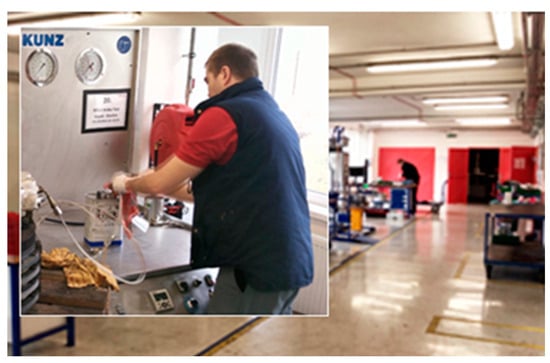
Figure 1.
Maintenance workplace.
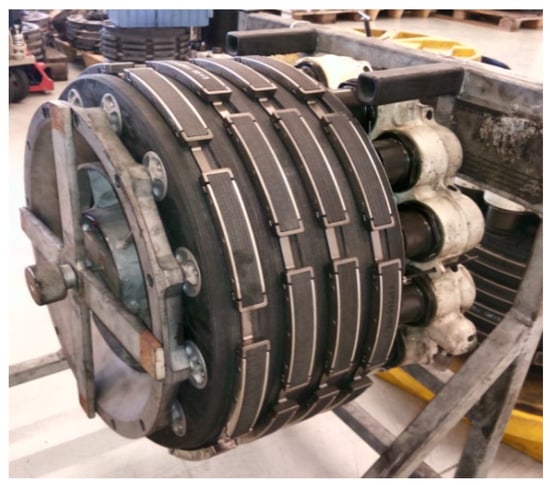
Figure 2.
Multi-disc brake.
Despite the high degree of automation in maintenance processes and efforts to minimize manual labor, the non-automated assembly still accounts for a high proportion of maintenance operations, depending on the type of maintenance. This is due to the complexity and diversity of assembly tasks and the resulting difficulty, even impossibility, of automating these tasks.
The main process takes place at the assembly workplace, which includes trays, pallets, tools, instruments, etc. In this process, the human acts as an integrating element, which purposefully creates interactions and links between the individual elements to achieve the desired maintenance result of the selected aircraft structural unit.
In order to promote the desire for employees to work safely and efficiently in organizations employing ground-based aviation specialists, it is necessary to promote positive attitudes toward operational safety in the context of minimizing ergonomic risks. At the same time, by using modern progressive computer tools, they should systematically monitor and evaluate their habits in terms of modern ergonomics and train them on work habits in order to provide the most suitable working environment with regard to their musculoskeletal system.
The task was solved on the basis o” a request from practice, namely in cooperation with a remote workplace of the international aviation company ABT, which, in Slovakia, in addition to the redesign of aircraft interiors from all over the world, also primarily deals with the maintenance and certification of aircraft wheels and brakes.
The request from ABT Slovakia was:
- Analyze and simulate the work process of a maintenance workplace for two worker variants with anthropometrically different scales. Specifically, there is a need to characterize and model a variant of the biomechanical model of the piston cylinder block pressure control workstation as part of the brake design used in short- and medium-haul civil transport aircraft shows in Figure 3, in order to ensure the reliability of the human factor in maintenance and the consequent assurance of technical safety through the use of innovative tools.
 Figure 3. Airbus A320 aircraft brake design elements: 1: brake body; 2: piston block; 3: piston blade; 4: support disc; 5: mechanical wear indicator.
Figure 3. Airbus A320 aircraft brake design elements: 1: brake body; 2: piston block; 3: piston blade; 4: support disc; 5: mechanical wear indicator.
The requirement for the task solution is to ensure the result by using digital engineering, visualization, and simulation tools of PLM systems and digital factories. In order to create a digital copy of the piston block maintenance workstation and the individual components required for the analysis and subsequent ergonomic simulation, it was necessary to create these digital components in the form of CAD models. Innovative three-dimensional digitalization technologies must be used to create virtual models of these parts.
For the requirements of fast and accurate creation of digital copies of components, the only effective solution at present is the use of advanced three-dimensional digitization technology. The actual process of three-dimensional part digitization using a 3D scanner is only the initial step of the entire digital ergonomics process. The subsequent processing of the scanned data in the selected software in a classical 3D modeler into the final 3D model tends to take a lot longer compared to the digitization itself.
- B.
- Methods
Nowadays, there are trends to increase reliability not only in the design and assembly of aerospace equipment and systems. There is a change in philosophy, and it will be possible in the future to simulate the human–machine interface using off-site training methods without interfering with the real process and without the need to interrupt production.
For the purpose of expressing the degree of risk at work, we apply the RULA model. The RULA model is for the assessment of upper body posture in relation to the workplace and the man and machine creating an environmental unit together with it.
For the purpose of comparing the simulation model created for the evaluation of ergonomic conditions of the piston cylinder block pressure control workstation, a model was created that simulates an ergonomic risk without the need to create a simulation environment through Industry 4.0 tools at ATB, Slovakia. A model was created using a simulation program and the RULA assessment methodology.
In maintenance processes, for example, PLM modules take the human into account as an element of the system, and not just as a control element.
Real human biomechanical models such as the Tecnomatix platform Siemens Jack (TX Jack) module from Siemens’ Digital Enterprise system are implemented in PLM systems in the civil sector. This support enables the virtualization of work activities and the search for reserves already in the pre-production phase, but also the virtualization of the activities, such as a pilot in the cockpit at the motor level or a maintenance worker and the simulation of his actions, and physical load. On the basis of this virtualization, it is possible to optimize the activities of the pilot or the mechanic, so that he is not a weak point in the process.
In this kind of calculation, simulations are mainly aimed at identifying (revealing) psychomotor parameters (learned, acquired) during the performed activity, which are the subject of the following sections, where they are explained and applied to specific real case studies from practice.
The methodological procedure of the designer’s activity and the relation to ergonomic criteria and parameters are shown in the diagram in Figure 4.
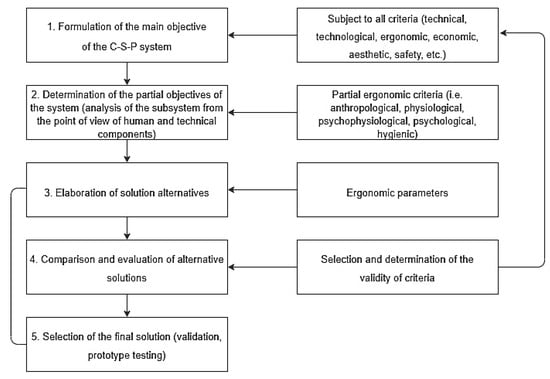
Figure 4.
The methodological procedure of the designer’s activity and the relation to ergonomic criteria and parameters.
Considering that the object of focus in the piston block maintenance work environment is their implementation in visualization, ergonomic design, and digitalization of imported elements, the scientific methods used are divided into two main groups.
Theoretical methods are divided into basic and specialized, with the basic ones creating an integrative environment for knowledge adaptation from interdisciplinary aeronautical and mechanical engineering disciplines.
Experimental methods are particularly important in terms of finalization and optimization of the exported ergonomic solutions of the maintenance workplace of the selected aircraft structural unit using SIEMENS PLM systems.
Given the specified objectives, the methods and tools of computer graphics and simulation play a key role in solving the problem. Basic imaging methods and graphical modeling, simulation techniques, and ergonomic risk assessment using progressive augmented reality are also important. Computer graphics, which is currently one of the most dynamically developing disciplines of computer-aided graphic design, is used for the methods and techniques by which factual data are converted and processed into two-dimensional and three-dimensional representations or by which graphical representations are converted and processed into factual data.
- C.
- EXPERIMENTAL SETUP
For fast and accurate import of objects, it is necessary to use progressive digitization methods. This part of the work is focused on creating digital images of selected structural elements in the working environment and objects in it using the digitalization method; the measuring stand for checking the pressure of the piston block is shown in Figure 5 on the right in the red circle. For the digitization of components, we cooperated with the Faculty of Electrical Engineering and Informatics of the Technical University of Kosice, LIRKIS Laboratory, and their 3D scanner Leica SCANSTATION 2, which is categorized as an active scanner with its own radiation source: laser.
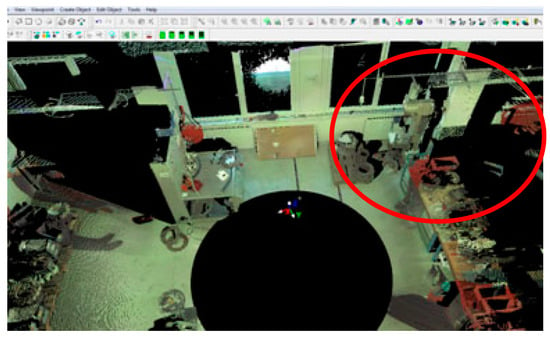
Figure 5.
LEICA SCANSTATION 2–3D Scanner and scanned maintenance workstation.
The principal sequence of steps in the simplified process of digitizing a piston block maintenance workplace from a real work environment is through a scanned point cloud to a virtual 3D model of the workplace without texture. A 3D model of the worker is shown in Figure 6. Creating a 3D object is a process that involves more than just 3D scanning and data processing. Experience and practice with scanned data have shown that we do not modify the scanned polygon mesh with individual functions in the software due to the fact that it is quite a time-consuming process. We modify the scanned data directly in the Rapid form XOR software before importing and using the scan in the TX Jack working environment. In Rapid form XOR, the resulting deviation between the scanned part and the real model is determined.

Figure 6.
The process of creating a 3D model of the slat: (1) original object; (2) scan (point cloud); (3) scanned object; (4) textureless model.
The resulting format of the visualization of the piston block maintenance work environment created using the 3D scanner is shown in Figure 7. In Figure 7, the comparison on the right shows the “digital noise” that needs to be cleaned up so that it does not obscure the important work environment data needed for the visualization and subsequent ergonomic analyses.

Figure 7.
Virtual model of a piston block maintenance workplace scanned with a LEICA 3D scanner.
Figure 8 shows the “cleaned” version of the scan of the real workplace and also the correlated orientation of the scanned surface with respect to the global coordinate system also used in the TX Jack modeling tool.
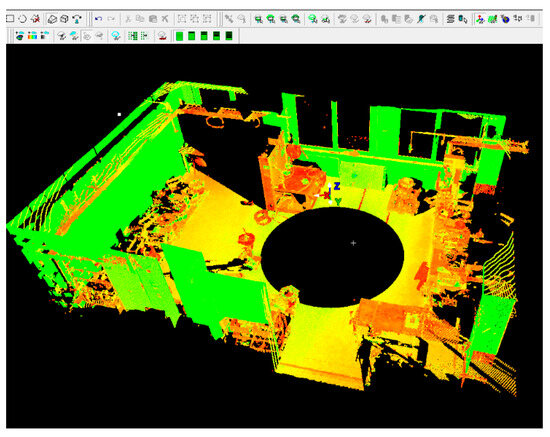
Figure 8.
Correlation of piston block maintenance workplace model scanned by LEICA 3D scanner.
Figure 9 shows the preparatory phase of the ergonomic design solution for the piston block maintenance workplace, specifically its pressure control stand. The cleaned version of the real workstation scan is also centered based on the orientation of the scanned surface with respect to the global coordinate system also used in the TX Jack modeling tool.

Figure 9.
External data import source translator function window.
After opening the software work box, it is necessary to load the required scanned data. A function for translating external sources is also initiated at the same time. This function translates the external data into the native. The object extension format that TX Jack can work with, as well as the individual sizes, are correlated with the coordinate center using the built-in SCALE FIGURE function, shown in Figure 10.
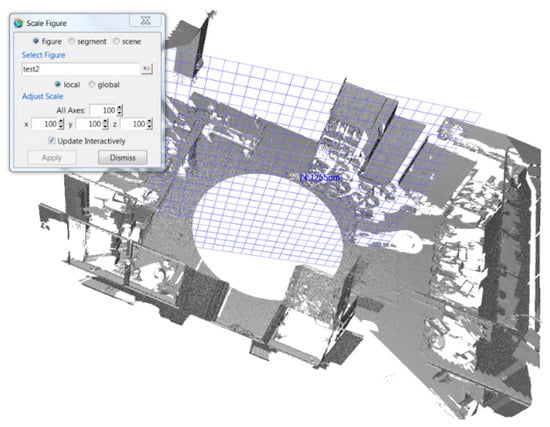
Figure 10.
Correlation External data import source translator function window.
Using the LEICA SCANSTATION 2–3D scanner, a general algorithm for solving the 3D model and its creation procedure was developed based on the knowledge obtained after creating three-dimensional models of the maintenance workplace containing construction elements of aircraft structural nodes. The diagram in Figure 11 illustrates the general algorithm.
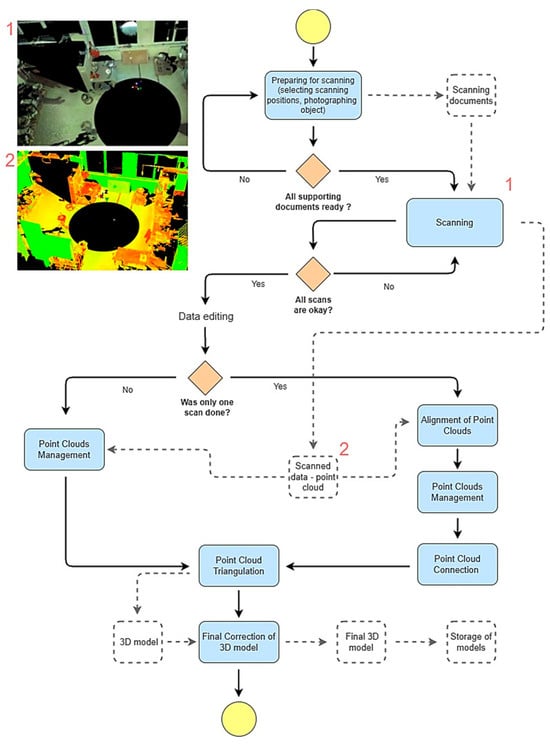
Figure 11.
General scheme of digital model creation using 3D scanning.
Application of TX Jack progressive tools in the simulation and evaluation of the aerospace component maintenance workplace followed.
The aim of the simulation of a maintenance workplace with an embedded 3D human biomechanical model was to compare two anthropometrically different model variants working on the pressure control design of a brake piston block used in short-haul and medium-haul transport aircraft. The ergonomic analysis was aimed at identifying the critical, i.e., most stressed, areas that could be sites of initiation of musculoskeletal overloads. For this purpose, a RULA analysis was performed in the TX Jack software, which is used to assess the load on different parts of the human body during the performance of cyclically repeated activities. It is primarily used to assess the risk of damage to the upper limbs that arises from work-related activities. However, this methodology includes the assessment of postures not only of the upper limbs (arms, forearms, and wrists) but also of the neck, spine, and legs. The result of the analysis is a calculated score that indicates the level of need to make changes to work practices. This activity was simulated using two 3D biomechanical models.
Through the creation of a 3D model of the Siemens TX Jack working environment and the point cloud translations of the Rapid form XOR environment, the geometry of the entire part can be continuously converted. Before the actual transformation of the selected WRML model, it is advisable to modify this model for the needs of task corrections, converting it to a native shape and adjusting the sizes of the individual metrics, triangulation axis center correlation, etc. The methods of simplifying the model include geometry feature suppression, geometry cleaning, and geometry idealization.
After the process of importing the working environment from the scanned data, Figure 12 follows the data correlation and scaling. The setting and aligning of the coordinates to a uniform axial center and dimension realization is followed by the phase of immortalizing the real biomechanical model from the embedding menu in the TX Jack software solution.
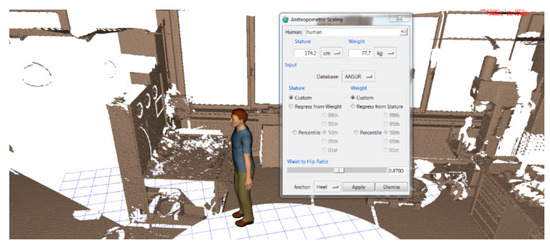
Figure 12.
Scanning of the working environment and preparation of a 3D model of a worker with a height of 174 cm.
After the selection, its measurements were defined from the choice of environment. Figure 12 shows the Anthropometric Scaling menu, setting the biomechanical model from the population perspective and providing the options to set basic parameters such as:
- height,
- human weight,
- percentile of the selected sample of the racial population for each continent.
The next step necessary for the creation of the simulation of the maintenance work activity and the subsequent ergonomic analysis is the insertion of the brake object under investigation from the NX SW module, shown in Figure 13.
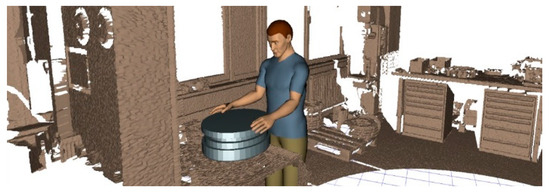
Figure 13.
Assigning and object created in SIEMENS NX CAD software.
The Ruler function for distance measurement and the View Cones function, shown in Figure 14, can also be used to provide workstation control. In Figure 15, the same procedure is then repeated with a worker with a height of 190 cm.

Figure 14.
Using the View Cones feature.

Figure 15.
Scanning of the working environment and preparation of a 3D model of a worker with a height of 174 cm and 190 cm.
3. Ergonomic Analysis and Discussion
From the comparison of the individual dimensions of the embedded biomechanical models and their dimensions in Figure 15, it is evident to see the comparison of the individual reaches of the upper limbs during the inspection operations of the discs, brakes, and their selected components of the structural nodes.
- A.
- Ergonomic analysis and interpretation of results
During the maintenance process of the selected component, a 174 cm tall worker has his forelimbs bent at the elbows. The bending of the upper limbs at the elbows is highlighted in solid yellow using the RULA method in Figure 16. This indicates that according to Slovak legislation, the working position is conditionally acceptable.
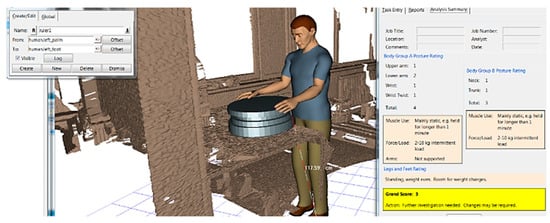
Figure 16.
Results of RULA analyses worker with height 174 cm.
The other values of the analyses based on the bending of the individual body positions are green and are in accordance with Slovak legislation. In the next steps, impact and collision analyses were also performed using the Plant SIMULATION Siemens PLM software. Figure 17 shows the results of the RULA analysis for a worker with a height of 190 cm. Employee height models were used because the average height of employees in a maintenance organization is between 174 and 190 cm.

Figure 17.
Results of RULA analyses worker with height 190 cm.
From the comparison of the results, the shoulder is loaded at level 3. The forearm is loaded at level 2. The wrist is loaded at level 3 and the wrist sprain is at level 1. The total body load within group A, which includes the shoulder, forearm, and wrist, is at level 6.
Body group B includes the knees and spine. The knees are loaded at level 2 and the spine is loaded at level 4. The total load of group B is at level 6. The results of the dynamic analysis of the work environment show that the worker’s working position is unfavorable. The load level is at level 7. Therefore, it is necessary to change this position to achieve a lower load on the worker.
- B.
- Discussion of the findings
Figure 18 shows the layout model required for the ergonomic human factors assessment. This model reflects the layout requirements from the initial layout assumptions for the location of the airbrake maintenance operation in the selected plant as it already exists. The space is given by a clear area of 20 m × 14 m.

Figure 18.
Resulting maintenance workplace model simulated in PLANT SIMULATION.
To create a workplace modification proposal, simulation in TX Jack was chosen due to the speed of comparing workplace modifications. According to the previous simulations, it is necessary to modify the handling plane when inspecting the component, shown in Figure 19. The positioning of the part on the inspection is ergonomically fine. According to Figure 20, the optimum handling plane for a standing worker with a height of 190 cm is above 100 cm.

Figure 19.
Created model of a piston block pressure control stand for the maintenance of chassis parts.
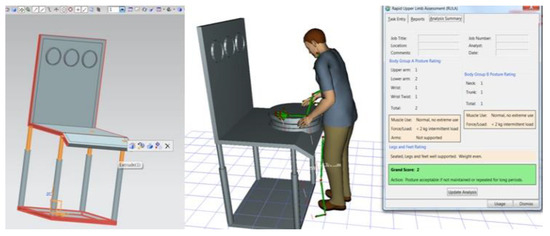
Figure 20.
Created model of piston block pressure control stand for the maintenance of chassis parts.
The TESTER-STEND positional control was constructed in Siemens NX and its 3D model, on the left side of Figure 19, was imported into the TX Jack simulation software, see the right side of Figure 19, and then the analyses from the previous chapters were re-run.
After designing a solution for the reorganization of the ergonomic project, a model of a positional stand on movable struts with the possibility of locking at the desired height was designed.
The work analysis for the above model and its results are depicted in the summary in Figure 20, showing the result of the ergonomic evaluation of the working position using the RULA method. As can be seen, all the results are in an acceptable working position, which is also shown in Figure 21 in the green depiction in the individual spectra of the simulation evaluation for other methods SSP, OWAS, and LBA.
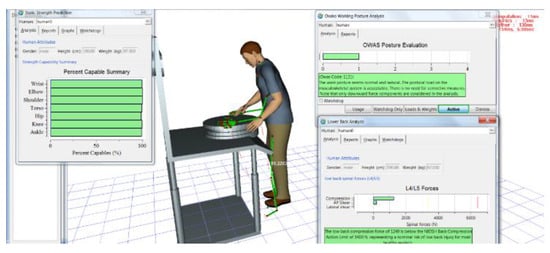
Figure 21.
Summary results of ergonomics methods SSP, LBA, OWAS.
The result of the LBA method did not exceed the applied force on the L4/L5 vertebrae of 2000 N or the limiting horizon of 6400 N. It was at the level of 1200 N and thus confirmed the validity of a simple modular adaptation of the working manipulation plane to the work needs of individual workers according to their height.
When evaluating ergonomics using the RULA method, a predetermined procedure is followed. In the first phase, the posture is evaluated in a package—neck, spine, and legs. For the evaluation, a table is created in which the values of the neck posture are recorded, and at the same time, the points express the intensity of the stress. The same procedure is followed for the spine and legs. By combining the tables created in this way, one resulting table will be created. The multi-criteria table created in this way is used to calculate the total value of posture stress. For better results, the resulting value of the product of individual results is multiplied by a relative constant whose maximum value is T = 1. This constant represents the value of a work shift (usually 8 h). The product of variables itself is a logarithmic product of variables. The RULA multi-criteria score table is provided in Table 2.

Table 2.
Rula multi-criteria score table.
The logarithmic function is added for plotting. In the case of a logarithmic function, the resulting interval can be divided into four categories. Each category has a different value scale.
The example of displaying the logarithmic function is used to visualize how the given risk is then evaluated. In the case of a logarithmic function, it is sufficient to divide the entire interval into N equal parts. N represents the scale on the risk scale. We set the division of the scale into three levels for the sake of easier filling of the questionnaires, which are carried out during the collection of data from the workers.
The definition of risk is a combination of the probability of occurrence and severity. From this definition, we can therefore conclude that repeated activity will be the occurrence of the probability translated by the percentile of the occurrence of fulfilment in the past.
We are able to reach the following conclusion as a result of the simulation proposed stand´s model, and the study of the working environment.
The methodology used the basics of RULA, where individual postures are evaluated from 1 to 5 after the first degree.
This method serves to compare results or quickly evaluate job positions. At the same time, it provides a quick estimate of the risk of musculoskeletal strain during work.
Hand postures are added up as follows: wrist position + elbow position + shoulder position = hand posture.
This is how individual moving groups of the human body are evaluated. Individual groups of the locomotor apparatus multiply among themselves. For easier scalability at the end, the entire result is given in a decimal logarithm. The subsequent value of the result is divided into five degrees. If there are five groups, while the group of the highest order will occupy the largest part of the imaginary graph, we can evaluate that the lowest level of risk represents the smallest section of a specific time and thus the risk rises the most.
Figure 22 below shows the functional mathematical model of the previous description. The maximum value that the evaluation model reaches is 2.35.

Figure 22.
Comparison with TX Jack model.
To compare the results from the computer simulation of ergonomics, we will convert the values into the new model, as shown in Figure 23.
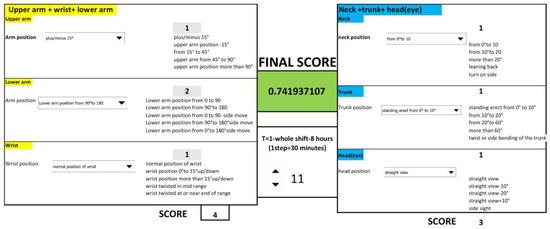
Figure 23.
Comparison with TX Jack model.
After entering the posture values into the created parent model, values were reached that indicate that a person can stay in each position for 4 h without wearing out any part of the musculoskeletal apparatus.
The main contributions of the present work to the development of the theory and methodology of ergonomic design and maintenance of aircraft structural assemblies can be summarized in the following points shown in Table 3.

Table 3.
Summary results of the contributions of the present work and final recommendations are able to reach the following conclusion as a result of the simulation proposed stand´s model, and the study of the working environment.
The results indicate that the investigated TESTER-STEND model with innovative adjustable pistons will contribute to the improvement of ergonomics and worker performance, and overall workplace safety.
4. Conclusions
The implementation of even the smallest change can be subject to high pressure to create the built-in risks associated with failure. Therefore, in the current period, all changes are feasible under the condition that they must be well-planned and thought through. To be truly perfect, the prepared project must exhibit all the parameters of a quality product, and this can determine the long-term effectiveness of a given operation.
Contributing to the high-quality design of a technical maintenance workplace in the aerospace industry are progressive technologies that are taking the issue of the technological design of work systems to a whole new level. The advantage of these technologies is their wide use, which brings, above all, quality, reliability, safety, and precision of design, especially in the phase of technical preparation of the working system with emphasis and consideration of the human being.
The main objective of the work was to analyze and simulate the work process of a maintenance workplace for two worker variants of anthropometrically different scales. Specifically, a biomechanical model variant was characterized and simulated for the workplace of pressure control of the roller piston block as part of the brake design used in civil transport aircraft for short and medium routes, with the aim of ensuring the reliability of the human factor in maintenance and consequently ensuring technical safety using innovative tools. The synthesis and analysis of the individual work tasks of maintenance personnel of selected landing gear parts of airplanes were carried out using the TECNOMATIX software solution. This includes the TX Jack software module aimed at ergonomic studies and at the modeling and simulation of the human factor in maintenance processes aimed at evaluating ergonomic positions.
The resulting remedial solution was the introduction of a concrete solution into the simulated environment, namely in the form of a “positional TESTER—STEND” control, which was constructed in the NX system, and its 3D model, was imported into the TX Jack simulation software, and then the analyses were re-run.
After designing a solution for the reorganization of the ergonomic project, a variant of a positional stand on movable struts with the possibility of locking at the desired height was proposed.
The future direction of the research will be directed towards the requirements of aviation maintenance organizations, the requirements to improve the ergonomics of maintenance personnel in the most strenuous activities using this methodology, virtual reality, and the application of these practices in individual maintenance activities.
The main objective of improving the manual workplace for the maintenance of aerospace components was to be able to create changes in a short time and with acceptable costs for an efficient workplace that will meet the conditions for achieving higher labor productivity, product quality, and at the same time create conditions for reducing physical and mental effort during assembly within the maintenance processes.
Author Contributions
Conceptualization, M.H. and P.K.; methodology, M.H. and S.A.-R.; software, M.H. and B.R.; validation, M.H., B.R. and M.V.; formal analysis, S.A.-R.; investigation, S.A.-R.; resources, M.H. and M.V.; writing—original draft preparation, M.H., S.A.-R. and M.V.; visualization, S.A.-R.; supervision, M.H. and P.K. All authors have read and agreed to the published version of the manuscript.
Funding
This research received no external funding.
Data Availability Statement
The data presented in this study are available on request from the corresponding author. The data are not publicly available due to third party.
Acknowledgments
This work was supported by the Slovak Research and Development Agency under the number APVV-20-0546—Innovative measurement of airspeed of unconventional flying vehicles and under contract number OPII-VA/DP/2021/9.3-01 within the “Research of an intelligent management logistics system with a focus on monitoring the hygienic safety of the logistics chain” project implemented under contract number 313011BWP9.
Conflicts of Interest
There is no conflicts in this manuscript.
References
- Voštová, V.; Helebrant, F.; Jeřábek, K. Operation and Maintenance of Machines, 1st ed.; Czech Technical University: Prague, Czech Republic, 2002; p. 124. ISBN 80-01-02531-4. [Google Scholar]
- Alessio, L.; Franco, G.; Tomei, F. Trattato di Medicina del Lavoro; Piccin: Padua, Italy, 2015. [Google Scholar]
- Caputo, F.; Greco, A.; Fera, M.; Macchiaroli, R. Digital twin to enhance the integration of ergonomics in the workplace design. Int. J. Ind. Ergon. 2019, 71, 20–31. [Google Scholar] [CrossRef]
- Caputo, F.; Greco, A.; Fera, M.; Macchiaroli, R. Workplace design ergonomic validation based on multiple human factors assessment methods and simulation. Prod. Manuf. Res. 2019, 7, 195–222. [Google Scholar] [CrossRef]
- Makarova, I.; Khabibullin, R.; Belyaev, E.; Mavrin, V.; Verkin, E. Creating a safe working environment via analyzing the ergonomic parameters of workplaces on an assembly conveyor. In Proceedings of the 2015 International Conference on Industrial Engineering and Systems Management (IESM), Seville, Spain, 21–23 October 2015. [Google Scholar]
- Case, K.; Hussain, A.; Marshall, R.; Summerskill, S.; Gyi, D. Digital human modelling and the ageing workforce. Procedia Manuf. 2015, 10, 3694–3701. [Google Scholar] [CrossRef]
- Tarallo, A.; Mozzillo, R.; Di Gironimo, G.; De Amicis, R. A cyber-physical system for production monitoring of manual manufacturing processes. Int. J. Interact. Des. Manuf. 2018, 12, 1235–1241. [Google Scholar] [CrossRef]
- Sanjog, J.; Patel, T.; Karmakar, S. Occupational ergonomics research and applied contextual design implementation for an industrial shop-floor workstation. Int. J. Ind. Ergon. 2018, 72, 188–198. [Google Scholar] [CrossRef]
- Greco, A.; Caterino, M.; Fera, M.; Gerbino, S. Digital Twin for Monitoring Ergonomics during Manufacturing Production. Appl. Sci. 2020, 10, 7758. [Google Scholar] [CrossRef]
- Afroz, S.; Haque, M.I. Ergonomics in the workplace for a better quality of work life. In Proceedings of the 15th International Conference on Ergonomics for Improved Productivity (HWWE 2017), Aligarh, India, 8–10 December 2017; Muzammil, M., Khan, A.A., Farooq, M., Hassan, F., Eds.; Excel Publishers: New Delhi, India, 2017; p. 70. [Google Scholar]
- Easwaran, N. Ergonomic analysis and workplace evaluation of an assembly section to improve productivity. In Proceedings of the 15th International Conference on Ergonomics for Improved Productivity (HWWE 2017), Aligarh, India, 8–10 December 2017; Muzammil, M., Khan, A.A., Farooq, M., Hassan, F., Eds.; Excel Publishers: New Delhi, India, 2017; p. 19. [Google Scholar]
- Zhang, X.; Chaffin, D.B. Digital human modeling for computer-aided ergonomics. In Handbook of Occupational Ergonomics; CRC Press: London, UK, 2005; pp. 1–13. [Google Scholar]
- Spada, S.; Germana, D.; Ghibaudo, L.; Sessa, F. Application and benefits of digital human models to improve the design of work cells in car’s manufacturing plants according to international standards. In Proceedings of the 11th International Conference on Manufacturing Research (ICMR 2013), Cranfield, UK, 19–20 September 2013; Available online: http://dspace.lib.cranfield.ac.uk/handle/1826/9490 (accessed on 12 May 2017).
- Fera, M.; Greco, A.; Caterino, M.; Gerbino, S.; Caputo, F.; Macchiaroli, R.; D’Amato, E. Towards Digital TwinImplementation for Assessing Production Line Performance and Balancing. Sensors 2020, 20, 97. [Google Scholar] [CrossRef]
- Kuruganti, U. 22—Sensors for monitoring workplace health. In Bioelectronics and Medical Devices; Woodhead Publishing Series in Electronic and Optical Materials; Woodhead Publishing: Cambridge, UK, 2019; pp. 537–553. [Google Scholar]
- Hajifar, S.; Sun, H.; Megahed, F.M.; Jones-Farmer, L.A.; Rashedi, E.; Cavuoto, L.A. A forecasting framework for predicting perceived fatigue: Using time series methods to forecast ratings of perceived exertion with features from wearable sensors. Appl. Ergon. 2021, 90, 103262. [Google Scholar] [CrossRef]
- Grandi, F.; Peruzzini, M.; Zanni, L.; Pellicciari, M. An Automatic Procedure Based on Virtual Ergonomic Analysis to Promote Human-Centric Manufacturing. Procedia Manuf. 2019, 38, 488–496. [Google Scholar]
- Rivera, F.G.; Rivera, F.G.; Brolin, E.; Syberfeldt, A.; Hogberg, D.; Pascual, A.I.; Luque, E.P. Using virtual reality and smart textiles to assess the design of workstations. In Advances in Transdisciplinary Engineering; IOS Press BV.: Amsterdam, The Netherlands, 2020; Volume 13, pp. 145–154. [Google Scholar]
- Reinhard, R.; Mårdberg, P.; García Rivera, F.; Forsberg, T.; Berce, A.; Fang, M.; Högberg, D. The Use and Usage of Virtual Reality Technologies in Planning and Implementing New Workstations. Adv. Transdiscipl. Eng. 2020, 11, 388–397. [Google Scholar]
- Amaral, D.C.; Rozenfeld, H.; Alliprandini, D.H.; Forcellini, F.A.; de Toledo, J.C.; Scalice, R.K.; da Silva, S.L. Product Development Management—A Reference for Process Improvement; Saraiva: São Paulo, Brazil, 2006; p. 576. (In Portuguese) [Google Scholar]
- Ottogalli, K.; Rosquete, D.; Rojo, J.; Amundarain, A.; Rodríguez, J.M.; Borro, D. Virtual Reality Simulation of Human-Robot Coexistence for an Aircraft Final Assembly Line: Process Evaluation and Ergonomics Assessment. Int. J. Comput. Integr. Manuf. 2021, 34, 975–995. [Google Scholar] [CrossRef]
- The Geiger, A.; Brandenburg, E.; Stark, R. Natural Virtual Reality User Interface to Define Assembly Sequences for Digital Human. Models. Appl. Syst. Innov. 2020, 3, 15. [Google Scholar] [CrossRef]
- Billing, E.; Bampouni, E.; Lamb, M. Automatic selection of viewpoint for digital human modelling. In Advances in Transdisciplinary Engineering; IOS Press BV.: Amsterdam, The Netherlands, 2020; Volume 11, pp. 61–70. [Google Scholar]
- Zhu, W.; Fan, X.; Zhang, Y. Applications and Research Trends of Digital Human Models in the Manufacturing Industry. Virtual Real. Intell. Hardw. 2019, 1, 558–579. [Google Scholar] [CrossRef]
- Ahmed, S.; Irshad, L.; Demirel, H.O.; Tumer, I.Y. A Comparison between virtual reality and digital human modeling for proactive ergonomic design. In Lecture Notes in Computer Science (Including Subseries Lecture Notes in Artificial Intelligence and Lecture Notes in Bioinformatics); LNCS.; Springer: Berlin/Heidelberg, Germany, 2019; Volume 11581, pp. 3–21. [Google Scholar]
- Beuß, F.; Sender, J.; Flügge, W. Ergonomics Simulation in Aircraft Manufacturing—Methods and Potentials. Proc. CIRP 2019, 81, 742–746. [Google Scholar] [CrossRef]
- Višňovský, J.; Naďová, Ľ.; Šajbidorová, M. Human Resource Management Resources, 2nd ed.; SPU: Njitra, Slovakia, 2007; p. 166. ISBN 978-80-8069-956-7. [Google Scholar]
- Korhan, O.; Fallaha, M.; Çınar, Z.M.; Zeeshan, Q. The impact of industry 4.0 on ergonomics. In Ergonomics—New Insights; IntechOpen: London, UK, 2023. [Google Scholar] [CrossRef]
- Lea.com. Definition and Domains of Ergonomics. 2019. Available online: https://www.iea.cc/whats/ (accessed on 12 February 2022).
- Tiecheng, Z. The study on the ergonomics of hand tractor based on digital human model. In Proceedings of the 2014 Sixth International Conference on Measuring Technology and Mechatronics Automation, Zhangjiajie, China, 10–11 January 2014; pp. 778–781. [Google Scholar] [CrossRef]
- Van der Molen, H.F.; Sluiter, J.K.; Hulshof, C.T.; Vink, P.; van Duivenbooden, C.; Holman, M.R. Frings-Dresen, M.H. Implementation of participatory ergonomics intervention in construction companies. Scand. J. Work Environ. Health 2005, 31, 191–204. [Google Scholar] [CrossRef]
- Tompa, E.; Dolinschi, R.; Natale, J. Economic evaluation of a participatory ergonomics intervention in a textile plant. Appl. Ergon. 2013, 44, 480–487. [Google Scholar] [CrossRef]
- Shikdar, A.A.; Sawaqed, N.M. Ergonomics, and occupational health and safety in the oil industry: A managers’ response. Comput. Ind. Eng. 2004, 47, 223–232. [Google Scholar] [CrossRef]
- Koglind-Öhman, I. Participatory Methods and Empowerment for Health and Safety Work: Case Studies in Norrbotten, Sweden; University of Oulu: Oulu, Finland, 2011. [Google Scholar]
- McAtamney, L.; Nigel Corlett, E. RULA: A survey method for the investigation of work-related upper limb disorders. Appl. Ergon. 1993, 24, 91–99. [Google Scholar] [CrossRef]
- Hignett, S.; McAtamney, L. Rapid Entire Body Assessment (REBA). Appl. Ergon. 2000, 31, 201–205. [Google Scholar] [CrossRef]
- David, G.C. Ergonomic methods for assessing exposure to risk factors for work-related musculoskeletal disorders. Occup. Med. 2005, 55, 190–199. [Google Scholar] [CrossRef]
- Zare, M.; Biau, S.; Croq, M.; Roquelaure, Y. Development of a biomechanical method for ergonomic evaluation: Comparison with observational methods. Int. J. Soc. Manag. Econ. Bus. Eng. 2014, 8, 223–227. [Google Scholar]
- MichelettiCremasco, M.; Giustetto, A.; Caffaro, F.; Colantoni, A.; Cavallo, E.; Grigolato, S. Risk Assessment for Musculoskeletal Disorders in Forestry: A Comparison between RULA and REBA in the Manual Feeding of a Wood-Chipper. Int. J. Environ. Res. Public Health 2019, 16, 793. [Google Scholar] [CrossRef]
- Hovanec, M.; Korba, P.; Solc, M. Tecnomatix for successful application in the area of simulation manufacturing and ergonomics. In Proceedings of the 15th International SGEM Geoconference on Informatics, Sofia, Bulgaria, 18–24 June 2015; STEF92 Technology Ltd.: Sofia, Bulgaria, 2015; pp. 347–352, ISBN 978-619-7105-34-6. [Google Scholar]
- Hovanec, M.; Rácek, B.; Vencel’, M.; Horkay, J.; Al-Rabeei, S. Selection of infection assessment site using fishbone diagram. In Proceedings of the New Trends in Aviation Development (NTAD), Stary Smokovec, Slovakia, 28–29 November 2023; pp. 117–122. [Google Scholar] [CrossRef]
- Caterino, M.; Rinaldi, M.; Fera, M. Digital ergonomics: An evaluation framework for the ergonomic risk assessment of heterogeneous workers. Int. J. Comput. Integr. Manuf. 2023, 36, 239–259. [Google Scholar] [CrossRef]
- Greco, A.; Cardilicchio, A.; Gerbino, S. X-reality for preliminary evaluation and training of 3d laser scanning process of large products. In Proceedings of the International Joint Conference on Mechanics, Design Engineering & Advanced Manufacturing, Ischia, Italy, 1–3 June 2022; Springer International Publishing: Cham, Switzerland, 2022; pp. 1364–1375. [Google Scholar]
- Krulak, D.C. Human factors in maintenance: Impact on aircraft mishap frequency and severity. Aviat. Space Environ. Med. 2004, 75, 429–432. [Google Scholar]
- Hovanec, M.; Sinay, J.; Pačaiová, H. Application of proactive ergonomics utilizing digital plant methods based on augmented reality as a tool improving prevention for employees—2014. In Proceedings of the International Symposium on Occupational Safety and Hygiene, Guimares, Portugalsko, 13–14 February 2014; SPOSHO: Guimares, Portugal, 2014; pp. 182–185, ISBN 978-989-98203-2-6. [Google Scholar]
- Socha, V.; Socha, L.; Hanakova, L.; Valenta, V.; Kusmirek, S.; Lalis, A. Pilots’ Performance and Workload Assessment: Transition from Analogue to Glass-Cockpit. Appl. Sci. 2020, 10, 5211. [Google Scholar] [CrossRef]
- Kale, U.; Alharasees, O.; Rohacs, J.; Rohacs, D. Aviation operators (pilots, ATCOs) decision-making process. Aircr. Eng. Aerosp. Technol. 2023, 95, 442–451. [Google Scholar] [CrossRef]
- Korba, P.; Balli, O.; Caliskan, H.; Al-Rabeei, S.; Kale, U. Energy, exergy, economic, environmental, and sustainability assessments of the CFM56-3 series turbofan engine used in the aviation sector. Energy 2023, 269, 126765. [Google Scholar] [CrossRef]
Disclaimer/Publisher’s Note: The statements, opinions and data contained in all publications are solely those of the individual author(s) and contributor(s) and not of MDPI and/or the editor(s). MDPI and/or the editor(s) disclaim responsibility for any injury to people or property resulting from any ideas, methods, instructions or products referred to in the content. |
© 2024 by the authors. Licensee MDPI, Basel, Switzerland. This article is an open access article distributed under the terms and conditions of the Creative Commons Attribution (CC BY) license (https://creativecommons.org/licenses/by/4.0/).